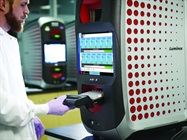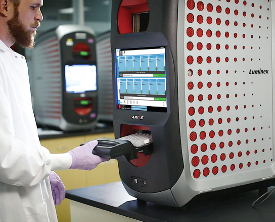Featured Article

Beyond ease and economy, automated platforms also improve accuracy
Evolution of automation has moved beyond new technology to new levels of use. “Traditionally laboratory automation is deployed to execute processes that are deemed to be optimized or production-ready,” says Chris Grimley, vice president of marketing at Labcyte (Sunnyvale, Calif.). “In these situations, researchers have a good understanding of the individual steps of the process they plan to automate and where they can make adjustments to accommodate automation.” Scientists now employ automation in other areas, too. “In some cases, researchers want to pilot a process before turning it over to a production team,” says Grimley. “In other cases, researchers want to automate small, redundant processes that are supportive to several laboratory projects or workflows.”
The use of automation covers academic and commercial labs, plus healthcare facilities. With the right instrumentation, automation makes science easier and more accurate, and often more economical.
One of the basics
Liquid handling has been a key element of life science lab automation for years. “All labs can benefit from automated liquid-handling systems because they increase lab efficiency and improve consistency of pipetting processes by reducing the variability seen in manual pipetting,” says Garrett Voss, senior product manager for the Microlab NIMBUS at Hamilton Company (Reno, Nev.).
Even an entry-level system makes a difference. “The biggest benefits of an entry-level liquid-handling system are cost, size and time required to get your assays automated,” Voss says. Hamilton’s Microlab NIMBUS sits on a benchtop but still provides enough features for many labs. “In contrast to large, multi-integrated, high-end systems, the NIMBUS … integrated pipettor [is] ideally suited for automating a single or select set of liquid-handling routines,” Voss explains. “This allows labs to quickly add automation … with less capital expenditure.”
The NIMBUS can use eight independent pipetting channels, or a 96- or 384-channel multiprobe head, any of which include Hamilton’s patented CO-RE (Compressed O-Ring Expansion) technology for tip attachment. “CO-RE is a robust lock-and-key mechanism to attach tips and channel tools, such as CO-RE Paddles for labware transportation,” Voss says. “CO-RE ensures tip attachment and eliminates the concern of dropping tips while minimizing the production of aerosols.”
This system can also adapt to new uses in the lab. “The flexible deck layout allows for a broad range of modular accessories and options [to be used] to configure the system based on … assay requirements,” Voss says.
Hamilton develops prepackaged automation solutions for specific applications, such as ELISA processing, DNA size selection and PCR setup.
In an entry-level system, scientists might also consider ease of use. Software enhancements are allowing results to be achieved more quickly by users requiring less training than was needed in the past. Manufacturers compete to develop flexible systems or to address a range of applications and employ field specialists to engage with customers, all with the purpose of serving users’ needs.
Hands off
 Even entry-level systems like the Microlab NIMBUS make a big difference in productivity. (Image courtesy of Hamilton Company.)
Even entry-level systems like the Microlab NIMBUS make a big difference in productivity. (Image courtesy of Hamilton Company.)Automation is also used where manual approaches fail. As Grimley says, “There are cases where researchers are leveraging automation to perform tasks that cannot be easily performed by hand.” With the Labcyte Echo liquid handler, Grimley points out, “researchers can transfer libraries of small amounts of DNA into a normalized pool of libraries for sequencing without diluting high-concentration libraries.” He adds, “To do this by hand would require the ability to pipette less than 100 nanoliters, which is considered impossible by most.”
Even if a process doesn’t require small sample sizes, the right automation solution can still drive significant financial benefits. Grimley says, “Echo liquid handlers enable significant cost reductions by enabling assay miniaturization—often by 100-fold—and by eliminating the need for pipette tips.”
 Access workstations are being used with integrated Echo liquid handlers in cancer research. (Image courtesy of Labcyte.)
Access workstations are being used with integrated Echo liquid handlers in cancer research. (Image courtesy of Labcyte.)In clinical applications, such as diagnostics, eliminating manual steps can speed up and simplify processes and reduce user error. Alan Neo, product manager for ARIES at Luminex (Austin, Texas), says that his company’s ARIES system “integrates nucleic-acid extraction and amplification steps into a single cassette, reducing the need to transfer samples from one system to another.” He adds, “The ARIES system software can then be linked to a laboratory information system to transmit information directly to the laboratory director without further interaction from the technician.”
Creative collaborations
To put the most advanced automation to use, some companies team up with vendors. Grimley says, “Labcyte has a collaboration with multinational pharmaceutical company AstraZeneca [Cambridge, U.K.] that involves using acoustic liquid-handling technology to load a mass spectrometer.” According to Grimley, speed constraints in sample preparation limit the use of mass spectrometry in high-throughput screening. “Acoustic loading using the Labcyte system solves the throughput issue as sample processing is an order of magnitude faster; plus it’s label-free, which greatly reduces project costs and provides more biologically relevant data,” he says.
 Automating a lab makes things go faster and produces more accurate results, as shown here with the ARIES system. (Image courtesy of Luminex.)
Automating a lab makes things go faster and produces more accurate results, as shown here with the ARIES system. (Image courtesy of Luminex.)Labcyte also helps scientists use its automation technology to fight cancer. “Researchers at the Institute of Molecular Medicine in Finland use Labcyte’s Access workstations with integrated Echo liquid handlers to test novel combinations of clinically approved drugs to treat cancer,” Grimley says. “Their work has already proven to extend the lives of patients with leukemia and has helped guide the efforts of larger pharmaceutical manufacturers targeting leukemia.”
The collaborations can also benefit students. At Stanford University in California, students in Richard Zare’s chemistry lab used induction-based fluidics (IBF) technology from nanoLiter (Henderson, Nev.) to load nanoliter samples into a mass spectrometer. This “required essentially no training, as they used a cell phone and a simple Android interface for control,” according to Drew Sauter, president of nanoLiter.
As Sauter explains, “Induction-based fluidics essentially turns dispensers— syringes, pipettes, pumps, liquid chromatographs—into inkjets, but they print everything—not just ink, even blood.” He adds, “Maintenance is low as there are no moving parts, other than the robotic section in such applications.”
In addition to simplicity, nanoLiter’s technology makes the most of samples. It “puts 100% of liquid samples—more than 1000 times the normal electrospray ionization amounts—into any electrospray ionization mass spectrometer in as fast as milliseconds, the fastest in the world,” Sauter says. “Also, the same versatile IBF system can be employed to make excellent MALDI [matrix-assisted laser desorption ionization], SIMS [secondary ion mass spectrometry] and LDI [laser desorption ionization] crystals that typically yield [about a] 20× improvement in sensitivity as shown by [various researchers] for drugs of abuse, proteins, polymers and chelated lanthanide and actinide metals, as [shown] in more than six peer-reviewed articles.”
Dedicated or adaptable
When looking for automation equipment, a scientist might prefer a device that does one thing and does it easily. Conversely, a more adaptable device could require more of a learning curve but also be flexible for future lab needs. “While the upfront cost of a more capable and flexible instrument like the Echo liquid handler may be intimidating for an academic lab, the long-term benefits can be very significant,” Grimley explains. “The ability to miniaturize assays can drive large savings, plus contact-free transfers eliminate pipette tip costs and often improve data quality and reproducibility.”
Adaptability can really benefit data analysis. Kevin Welling, product manager for SYNCT at Luminex, says his company’s SYNCT software “empowers laboratorians to manage data from any place in the lab.” As he notes, “Designed specifically for molecular labs, the software provides flexible, customizable workflows by connecting all lab workstations.” This software also lets users combine data from multiple instruments. You can “manage results from all next-generation Luminex instruments in one location,” says Welling.
Ultimately, the right automation depends on the lab and applications. The gains in the end usually offset any time and learning needed at the start. And the gains keep on giving.
Mike May is a freelance writer and editor living in Florida. He can be reached at [email protected].